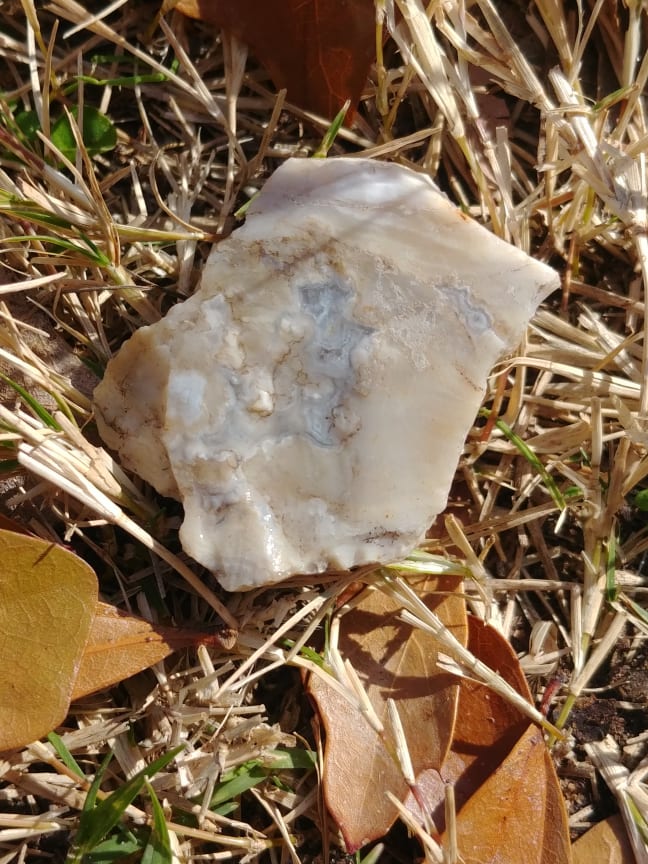kyoti
has rocks in the head
  
Member since June 2020
Posts: 542
|
Post by kyoti on Dec 30, 2020 10:22:54 GMT -5
I was out lounging on my patio the other morning and it was a bit damp. I was admiring my zen patio rocks when I noticed that one of the chert pieces had a pattern I recognized. I picked the little guy up and sure enough it was a fortification...in my chert! What's up with that? I mean, I get that cryptocrystalline quartz is cryptocrystalline quartz but an agate in a chert? 😀😀 Normal Texas chert beloved by knappers.  Closer...  Closer..  It doesn't look like a banded chert. It's definitely got fortifications in it. I feel like that old Reese's peanut butter commercial. You've got chocolate in my peanut butter lol |
|
|
|
Post by jasoninsd on Dec 30, 2020 11:06:10 GMT -5
Wowza! I'm in love...a rock with fortifications...it doesn't get much better than that!  Beautiful rock and way to spot it during your "zen" moments!  Fairburn Agates that have that type of white banding are called Ghost Fairburns...and they are dreamy!  Love it, love it, love it! |
|
kyoti
has rocks in the head
  
Member since June 2020
Posts: 542
|
Post by kyoti on Jan 1, 2021 9:44:06 GMT -5
Thanks jasoninsd ! Ya I was super stoked when I saw it. I hadn't heard of chert agates before. I scooped up a couple more off the patio to tumble. One of them which started off opaque white is actually swirly translucent white whith bands after rough grinding for a week. I'll hunt for more next time I'm at that spot. I really thought it was all chert or flint because the host rock looks a lot like limestone. Heres a look at the host rocks.   |
|
|
|
Post by 1dave on Jan 1, 2021 10:42:48 GMT -5
We are just barely beginning to understand SiO2. A BIG breakthrough came with "Hydration of Silica and Its Role in the Formation of Quartz Veins – Part 1" by John Elliston. It is taking a long time to be accepted, but a recent Masters Thesis gives gravitas. This is how most of the natural silica gel is formed world wide! Every shock wave has the potential to generate a lot of silica gel which turns into opal, spheroids, chalcedony and moganite fibers. Suspended in the gel are billions of nano-sized shards of shattered quartz and feldspar crystals. If the groundwater carrying the gel fills the void, these particles begin to attach to all walls. Usually the first layer is a very fine-grained material, chalcedony, which is a mixture of quartz and moganite. Then you have more moganite, then coarse-grained quartz crystals. The void dries out. Then is refilled, and the process is repeated dozens to hundreds of more times. If the void is not filled, gravity pulls the larger particles to the bottom until the next fill sequence begins. These are known to the scientific community as Uruguay Bands as they were first studied in geodes from Uruguay.   |
|
kyoti
has rocks in the head
  
Member since June 2020
Posts: 542
|
Post by kyoti on Jan 1, 2021 11:43:44 GMT -5
Thanks for posting there thesis 1dave . It was an interesting read. I think the last two paragraphs may apply to this host rock. Many of the rocks are filled with millions of tiny quartz crystals. In fact the whole rock is sometimes sugary quartz crystals. The larger boulders typically have bands or pockets of bands of chert veins. Possibly from fault action? One thing I found interesting was that the thesis talked about how the gels could form opal or chalcedony based material. When I first found these rocks, I actually thought they were common opal. They were almost all opaque white and felt very light compared to a normal stone and had a slick texture to them. |
|